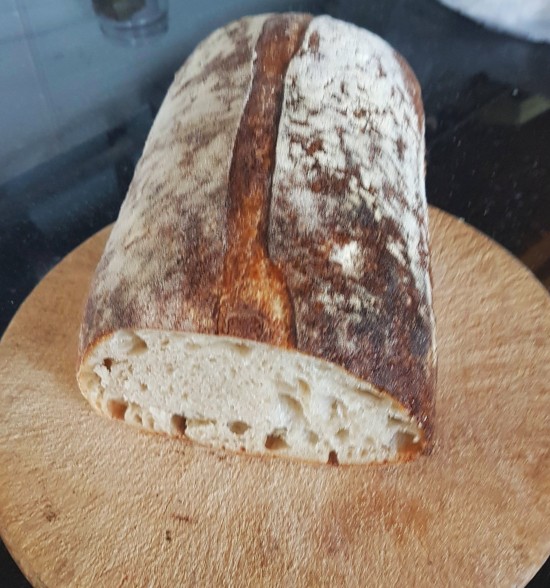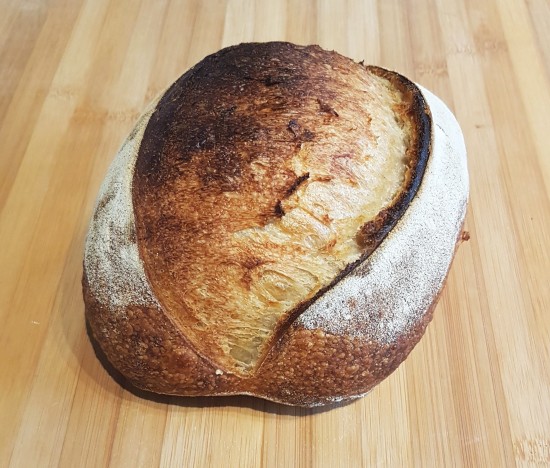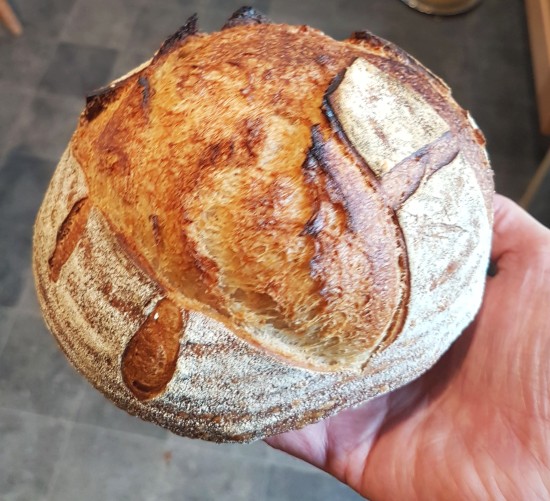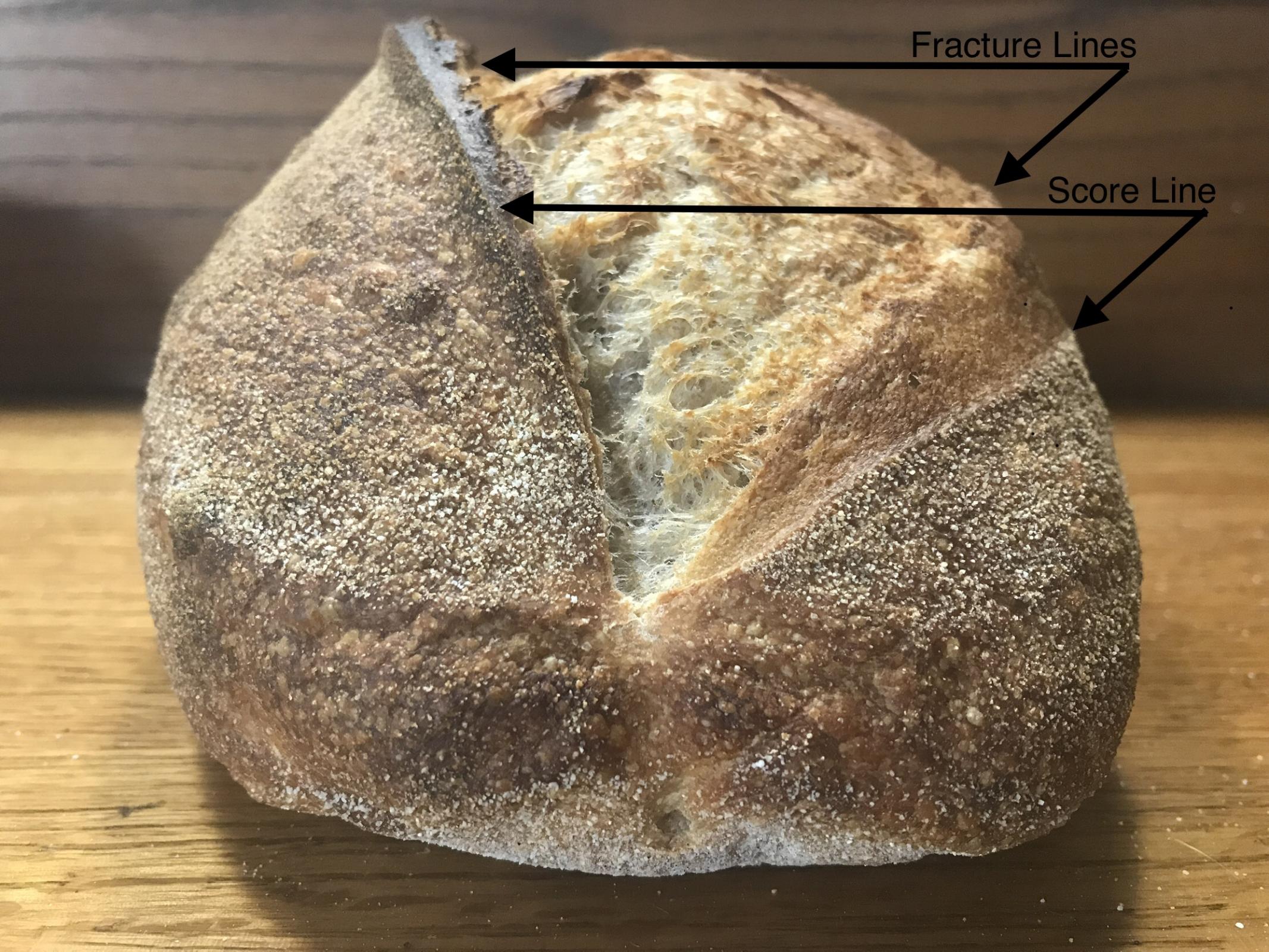
More musings on ears
I have recently been plagued by an attack of poor ears. I've been getting the kind where the cut seems to reseal itself in the oven, like this:

I looked back in my notes to previous bakes and realised that I'd started mixing less, in the pursuit of a more open crumb.
So I reverted to my old mixing regime and also did a longer autolyse than I usually do - 30 mins plus 15 mins fermentolyse (not long by most peoples' standards, I know). I immediately realised that the dough was much more supple and easy to handle.
The other interesting thing is that bulk time was much shorter than I've had lately - about 3.5 hours vs. 5 hours. I can only think that if the dough is weak, then the alveoli burst easily and the dough struggles to increase in height.
And here's what the loaves looked like this morning:


I was also rewarded with good loft and a nice moist, flexible crumb.
It goes to show that many factors affect ears, and everything has to be right to get good ones.
Lance


Those look great Lance.
Benny
Thanks Benny!
I agree Lance there are many, many factors but in a word it is all about "strength". You can't get a bloom like that without really good dough strength.
I'm not one for no-knead methods as I can't resist the urge to fully or near fully develop the dough. Without good gluten development I feel the process is incomplete. However I am in favour of reaching that goal with more passive means because over oxidation even with hand kneading is a problem. But since a SD starter is acidic it invokes oxidation anyway so I not sure how this really plays out.
Nice loaves well done!
Michael
I agree Michael - and thank you for your comment. I do think there is a temptation to under-develop the dough in pursuit of open crumb, but I'm coming to the conclusion that this is misguided.
Having a strong dough stops it spreading on the peel and in the oven and powerful oven spring pushes the dough up through the score, helping the crumb to open up.
Of course, it can be overdone, but this is where the bakers skill and sometimes luck (for amateurs like me!) come in.
Lance
Lance, for the last month I have been working and experimenting to get a handle on dough strength vs. dough extensibility. I posed the question HERE (that didn’t get much traction) of Autolyse as it relates to hydration. It seems a dough can become extensible via lengthy autolyse and/or increased hydration. I wonder the pros and cons of each method.
My present thinking is strength (well developed gluten with thick membrane) allows containment of rapidly expanding gasses. But when you think about that, so does highly extensible dough. The thin skin easily stretches to accommodate the expanding gas, but is more fragile. But most important to the production of ears is that the strong gluten in the outer skin is subject to fracture violently near the score line producing stellar time lapse video.
But, with that said, many prominent bakers get outrageous ears and bloom when using highly extensible dough. Point in case, lately I have been closely studying Kristen of Full Proof Baking. I have watched this VIDEO over and over and over again. She has uses a 2-4 hour autolyse (3 hr is her favorite) on a dough that is 80% hydrated! Her breads are museum quality, rivaling those of any baker I know. Outrageous open crumb and gorgeous breads displaying proud and prominent ears are her hallmark.
NOTE - below are a few of my present thoughts.
The points above may well be incorrect and some wording inaccurate, but they represent my present thinking.
So, can the answer to the same question be yes and no...? With bread all things seem possible. Here is a video to contradict the second paragraph. Notice how slack the dough is in the beginning frames.
I conclude. Although I don’t fully understand, that both doughs that stand tall on the peel and also those that spread like a pan cake are each capable of producing ears, blooming, an attaining outrageous oven spring. I look forward to hearing from others...
Thanks Lance, for posing this question.
Danny
Do you still get the same open crumb this way?
Lance, concerning this bread.
What conclusions can me draw from this?
I really dislike it when I come to score a dough that is fragile and weak. Scoring a strong dough is a reason for confidence. But I bet the open crumb master don’t share my sentiment. They know something that we don’t...
Danny
Good points and good questions, Dan - as always! I will do my best....
The 75% hydration dough for this loaf seemed lifeless when I turned it out - it was sticky and difficult to work, extensible, but not elastic and not supple.
There was quite a lot of oven spring - you can just about see this in the rounded base, but no bloom.
Crumb was moderately open, but rather dry and, again, lifeless.
In contrast, the later 72.5% hydration dough was a pleasure to work - supple and full of vitality. It was NOT extensible - I usually bench rest for 30mins after preshape and then stitch. I just about managed to do the stitch shape, but the dough was reluctant. I should probably have done a simple letter fold.
Oven spring and bloom were spectacular. Crumb was slightly open but not spectacularly so:
And it made a nice fish finger butty!:
On the other hand, the crumb is a pleasure to eat - moist and it's like each piece of crumb connects to the next, unlike the earlier loaf where each piece of crumb was a separate entity. Difficult to explain, but maybe there is some kind of crumb quality factor, rather than just crumb openness? Instajorgen touchs on something similar in this IG post.
As I mentioned in my original post, bulk time was a lot shorter for the second bake. I've been noticing that a lot of pro IG bakers talk of bulk times of about 3 hours, eg the brilliant Simons_bread. I couldn't work out why my bulk was so much slower - I was suspecting my starter, but now I think a major factor is degree of dough development, for the reasons I previously stated.
Anyway I will try another well developed bake next time and see how it goes! I might try a longer autolyse, to see if I get some more extensibilty.
Lance
Instajorgen makes a whole lot of sense to me. We should begin judging our crumb by the cell walls and not the cell holes. That crumb pictured is world class! The crumb makes me salivate. It is something that I would really like to spread butter on and eat...
The only improvements for me would be a cooler bake producing a thinner and softer crust. OH! and lots more oven spring. But again, that it personal preference.
An observation that may or may not be correct. Breads with soakers, such as Hamelman’s Five-Grain Levain have historically produced this type of crumb for me. I wonder if there is something to this that we are not aware of? Could it be the gelatinous substance produced by the seed soaker? <Not Sure>
Lance. I think MANY of us (me for sure) are BF our dough too long. I am learning to trust my starter and rely upon, count on, believe in, and expect oven spring. Without it our breads are sub-par. Every great bread explodes in the oven!
Since I started watching my BF (for over proofing) like a hawk, all of my breads are rising up from the stone at the bottom edges.
And that bread started out looking like this.
Below is hyper oven spring. Notice the roundness of the loaf at the bottom. It jumped up off the stone. See Video.
I encourage anyone interested in learning to bake better bread to start taking in-oven time lapse videos of their bakes. There is absolutely no better way to learn what takes place with dough while baking. A cell phone and something to hold it still is all you need. I am happy to help anyone that is interested.
Autolyse vs increased Hydration
As an intermediate baker struggling to improve, I presently lean towards autolysing for increased extensibility. I am learning through much experimentation that it is unwise for unskilled bakers to think that more water will make our breads better. The inability to handle these super wet doughs are hindering intermediate bakers like myself from advancing our skills. Our time is better spent working with doughs of moderate hydration. All super successful bakers have something in common - confidence. Nothing gives birth to confidence more than success.
Disclaimer - please forgive any preachiness. I am excited about what I am learning and I think it to be true. My only intent is to share this with the great gang of people that have done so much to improve my bread baking.
Danny
Danny, you say you are watching for signs of over fermentation during BF like a hawk - what are you looking for to see if it is over fermented? I generally use a straight sided container and measure volume, but wondered if you were looking at something else.
That is a good question, that is not easily answered. I don’t want to let the dough get poofy. A little gas is good, but if the dough feels well inflated I am dismayed. I let it get away from me :( Rounded edges and a doomed top, slightly jiggly, but definitely not bubbly. For my breads, the magic happens in the oven. I don’t want bubbly dough before then. -Keep in mind, I don’t work with large percentages of whole grain-
Bread baking blows my mind. Many master bakers would disagree completely with the paragraph above. And their breads prove them right. The more I bake, the more I believe, “with bread all things are possible”.
If you really, really think about it and try to envision a 30-50% increase, the mental of image of that dough shouldn’t appear very inflated. Maybe it’s my starter, but under proofing is yet to be a problem. I guess I’m working myself up to another experiment.
Barry, what I have learned from baking, and videoing all of those bakes (estimate 40-60 loaves), for the last 2 months, my thinking has changed dramatically. I’ve baked bread for over 2 decades and don’t ever remember producing the oven spring that I am seeing on a consistent basis. Ears were super rare, maybe 5%. MAYBE! The bloom was weak and the score lines were sealed flat on the loaf. Open crumb (large holes) wasn’t happening. Don’t get me wrong, I often baked very nice breads with airy (sometimes nice lacy honeycomb) crumb. But absolutely nothing like what consistency comes out of the oven now. Even super slack doughs climb up off the stone with oven spring.
OH! Wait a minute, almost forgot. There is another huge asset that was added during those last months. I use mega amounts of steam. Without it, the results would not be nearly as good. I’m getting ready to come out of the closet and get super sacrilegious :-). I never vent the oven. Steam is injected for 90 seconds (~8-10oz water converted to steam). The door stays closed until the bake is complete. I like a moderately softer crust.
Dan
Hey Dan, this thread is amazing to learn from the experience of bakers posting here.
One of the things I've always thought I need to get in addition to the domed top was some bubbles on the surface and sides of the dough where it meets the bowl. This is what Maurizio says to watch for. Because of this my BF has always seemed to take longer than he estimates despite my keeping the dough at the temperatures he recommends 78-80*F.
I also like a somewhat softer crust and now I'm wondering what would happen if I didn't take the lid off the dutch oven after 20 mins and just leave it in there to bake while still dropping the temperature. Interesting that you aren't venting the oven anymore.
Benny
Benny, good experiment! Let us know your findings from leaving the top on. I am interested in the crust and crumb, but also the browning.
Yea! I would not argue with Maurizio’s findings. His results speak for themselves. Bread is a mysterious thing.
Trevor’s instructions don’t align with my findings either. And who can speak against his results?
Sometimes, we need to think outside the box, and try the unthinkable. Who knows what we might discover? Everyone knows that helicopters can’t fly...
We know what we know, but is that knowledge always correct? But we don’t know what we don’t know, and that is always correct.
Dan, are you sure that 8-10 oz of water is going into the oven as steam? I notice your pressure cooker is the type that can vent constantly to maintain a pressure - does some of your water go out as steam through the pressure cooker vent? Not that it matters too much because your system, just like mine, WORKS!
Do you think your oven is completely sealed to maintain steam in there for the duration of the bake even after you have switched it off? Do you physically seal off the vent?
Lance
Your right, Lance a small amount of steam does escape the jiggle valve, but I’m pretty sure it is negligible.
I used to work at Sealing my oven, but after baking with this method for quite a while now, I don’t think it matters. I quite sealing any vents.
Get this, Lance. If you bake in a dark environment (at night with no lights other than the one in the oven), you can actually see the steam rising off the stone and bread. You have to watch closely, but it is obvious that the steam is rising.
A bit late saying this, but regarding your pre-bake shot, Dan, I'm thinking that it must only be amateur bakers that can afford to have loaves that spread on the peel. Imagine if you had 2 dozen loaves turned out on a loader prior to going into the deck oven, but each one needed scoring.
I'm thinking if you had spready dough pieces, the early ones would be kissing each other by the time the last ones were scored.
Can any pro baker comment on my thoughts?
Not that it is wrong to have dough that spreads on the peel as long as it works for you in your baking environment.
Lance
Lance, it seems to me that any baker, commercial or not, that bakes all white flour bread dough that is 80% hydrated or higher has to deal with dough that spreads. Even after long retardation the wet doughs are still super slack.
For the last months, I’ve watched the dough bake through the oven door glass, and all high hydration doughs hit the stone looking like thick pancakes.
Is the above correct, or is there something I’m missing?
Dan
I won't speak for Lance but your viewpoint doesn't fit with me.
I think you are missing something... The adoption of a true firm mother starter...
My mother starter dough is 45% hydration (white UK flour 15% protein) and it can fight any spread and is the reason I don't use banettons. I free form rise 80% + dough no problem, proof 250% volume and have it spring like a mad man!
For a while I was using a 50% BF/50% wholewheat starter, but I decided this was counter-productive. I came to the conclusion that a large quantity of WW in the starter causes excessive acidity and possible dough degradation. Now I use 80-90% BF and the rest WW or a WW/Rye mix.
WRT starter hydration, I began at 100%, went down to 56% and have now gone up to 80%. I think this is the sweet spot, because it is still mixable with a spatula; go much lower and you have to start hand kneading it, which is messy and makes repeated builds a chore.
Lance
In the first image below, the crumb is open, but the dough had very little bloom and no ear. Why do you think that is? I’d like to hear the opinion of others.
The image below tells me that the score line fractured right away.
I say this because there is no shiny stretch line (See following image for explanation). If my thinking is correct this dough fractured very soon after being loaded in the oven.
I am very interested to learn what dough qualities are needed to obtain a quick fracture.
Pertaining to the image below.

The smooth shiny area between the lower score line and the lower fracture line indicates the amount of dough stretch that occurred before the score line fractured. I think the gas builds, the dough stretches, then the heat bakes that exposed area starts to cook (harden) the crust. As the crust hardens, the gas is still inflating. If all things go well something has to give as some point. When the hardening skin can no longer expand to accommodate the increasing gas, a beautiful fracture starts to open, and in a magical moment the weakened and expanding skin gives way and the bread blooms and the ear is manifested! <Glorious!>
I appreciate the input of others.
Danny
Just a guess, but perhaps it was made with a strong flour, fully developed gluten, too short bulk proof, bench proofed a while, retarded a bit late, then retarded a bit long, then taken out and allowed to come back to room temperature (at least the surface), then baked. Net result is a weak oven spring dominated by expansion of the alveoli in the warm zone between the still cold core and the overproofed surface, not enough gas to blow it open so you just get a little stretch.
Second photo: I think I see a stretch zone that covers most of the top of the loaf, with the break line about 2/3 of the way between edges of the slash.
Doc, I am thinking that the lower area marked Stretch Zone is correct.
Are you thinking that the high area marked Stretch Zone is were the fracture occurred?
The ear has the typical burn line that is well darkened, indicating to me that the fracture occurred earlier in the process. The small shiny crust marked in the lower area Stretch Zone leads me to believe that the break happened early in the bake.
What do you think?
Compare the top image with the bottom.
I am thinking that the right edge of high area marked Stretch Zone is were the fracture occurred. But you may be right.
Though it may have been a single break early in the bake that had two stages of expansion that were defined by the pre-bake temperature distribution in the dough.
duplicate for unknown reason
Both similar hydrations (75%/72.5%). Fairly similar composition. The first one I did a different mixing technique when adding bassinage (basically 4mins on speed 2, as opposed to 7mins speed 1). And bulk increase was 45% on first, 69% on second. I think I went for 45% on the first as a trial (2 trials at once - not good/but we all do it!) on the grounds that less bulk may leave more oomph in the dough for oven spring - something I have read.
My notes say first dough felt lifeless, second was supple and easy to work.
Both had similar post bulk treatment - 25min BR, 30min banneton rest then overnight frij. Bake from cold.
I think there was some peel spread on the first, but none on the second.
I reckon the main reason for the poor ears on the first was my bassinage mixing technique trial, which must have damaged the gluten structure already created (somehow!). And maybe bulk increase was a bit low too.
Anyway my ears are back now and I'm happy! But it does go to show, that in the weird business of breadmaking, what you think are small changes, can have dramatic effects!
And personally, I'm always going to shoot for that rock-solid look on the peel! I also now reckon that 60-70% bulk increase is my goal.
And lastly, regarding what you see in the oven, I have a 15min steam stand after steam injection (now down to 30s) and I reckon ears should be seen starting to develop after the first 5 mins, otherwise you probably aren't going to get any!
To finish, here's a couple of shots of last week's ears:
Lance
I'm eavesdropping here on a conversation between those at the top of their game but still with a genuine thirst for knowledge and quality. So much to learn, so much inspiration. Big smile on my face. Thank you all.